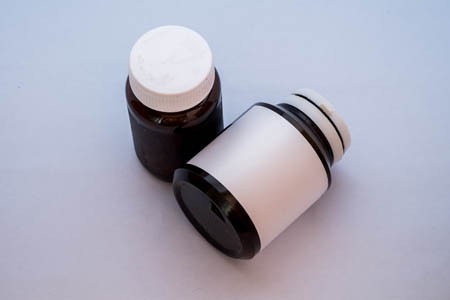Topiramate Plus Antipsychotic Medication Better Than Antipsychotics Alone for Schizophrenia Spectrum Disorders
 A 2016 meta-analysis has shown that the combination of the anticonvulsant topiramate and antipsychotic medication reduces symptoms of schizophrenia spectrum disorders more than antipsychotic medication alone. Researchers led by Christoph U. Correll analyzed the results of eight studies in which the topiramate-antipsychotic combination was compared to antipsychotics alone or with placebo.
A 2016 meta-analysis has shown that the combination of the anticonvulsant topiramate and antipsychotic medication reduces symptoms of schizophrenia spectrum disorders more than antipsychotic medication alone. Researchers led by Christoph U. Correll analyzed the results of eight studies in which the topiramate-antipsychotic combination was compared to antipsychotics alone or with placebo.
The combination of topiramate and antipsychotic medication was superior at reducing general psychopathology, including both negative and positive symptoms of schizophrenia. The combination was also associated with lower body weight and body mass index (BMI) compared to antipsychotics alone.
The studies included in the meta-analysis used a variety of antipsychotic medications. When these were compared, the combination of topiramate and clozapine was more effective than other combinations at reducing psychopathology. However, the combination of topiramate and clozapine was also associated with less weight loss than combinations using other antipsychotics.
In terms of side effects, topiramate was associated with more paresthesia (a burning or prickling sensation, often in the hands or feet) than placebo.
The study was published in the Journal of Clinical Psychiatry.
Mood Stabilizers with Atypical Antipsychotics Reduce Relapses Compared to Mood Stabilizers Alone or with Typical Antipsychotics
An Israeli study reports that treatment with mood stabilizers and atypical antipsychotics reduces bipolar relapses compared to treatment with mood stabilizers alone or mood stabilizers combined with typical antipsychotics. The study, by Eldar Hochman and colleagues in the journal Bipolar Disorders, compared one-year hospitalization rates after patients with bipolar disorder were discharged from the hospital following a manic episode. All of the 201 discharged patients were prescribed a mood stabilizer (lithium or valproate), and some were also prescribed an antipsychotic, either atypical or typical.
Those participants who received the combination of a mood stabilizer and an atypical antipsychotic had re-hospitalization rates of 6.3% compared to 24.3% of those who received mood stabilizers alone and 20.6% of those who received mood stabilizers with a typical antipsychotic.
While the study did not determine which treatment is best for ongoing maintenance treatment of bipolar disorder, it does suggest that the combination of mood stabilizers and atypical antipsychotics can reduce hospitalizations during the one-year period following a manic episode.
Combo of Memantine and Sertraline Effective for Unipolar Depression
A 2016 study in the Journal of Clinical Pharmacy and Therapeutics finds that the combination of memantine (Namenda), a drug used to treat Alzheimer’s disease, and the antidepressant sertraline (Zoloft) improved unipolar depression more than sertraline plus placebo.
The study by Meysam Amidfar and colleagues included 66 patients with moderate to severe unipolar depression. They were divided into two groups—one received sertraline plus memantine for six weeks, while the other received sertraline and a placebo.
The memantine group showed significantly greater improvement at 2 weeks, 4 weeks, and 6 weeks, and significantly greater response at 4 and 6 weeks. There were also more early improvers in the mematine group, and more rapid response to treatment. Both groups improved significantly over the six weeks of treatment.
Larger studies are needed to learn more about the safety and efficacy of memantine combined with sertraline for the treatment of unipolar depression, but this initial study is promising. In 2012, researcher Amit Anand and colleagues reported that in bipolar depression, memantine potentiates the effects of lamotrigine. Memantine also helped rapid cyclers when added to ongoing treatment in an open study of the drug treatment by Athanasios Koukopoulus and colleagues in 2012.
Arthritis Drug Celecoxib May Improve Bipolar Depression When Paired with Escitalopram
A new study suggests that for people with bipolar depression, the anti-inflammatory drug celecoxib (Celebrex), typically used to treat arthritis, can boost the effectiveness of the antidepressant escitalopram (Lexapro).
In the 8-week study by researcher Angelos Halaris and colleagues, adults with bipolar depression were randomly assigned to one of two groups. The first group received the selective-serotonin reuptake inhibitor (SSRI) antidepressant escitalopram plus celecoxib to target inflammation. The second group received just the antidepressant escitalopram and a placebo.
By the end of the study, 78% of the group taking the anti-arthritis drug had seen major improvement in their depression, with 63% reporting that it had lifted completely. Meanwhile in the placebo group, only 45% reported major improvement, and 10% reported remission.
The group that received celecoxib with their escitalopram also began seeing improvement within one week of beginning treatment, instead of after four to six weeks, which is typical of antidepressant treatment.
Researchers think depression creates an immune response leading to chronic inflammation, which can upset the balance of neurotransmitters in the brain and make antidepressants less effective. Halaris suggests that reducing this inflammation with a drug like celecoxib can make antidepressants more effective.
The research was presented at the Fifth International Congress on Psychiatry and the Neurosciences and has not yet been published.
Combination of SSRIs and Statins Better than SSRIs Alone
A large study in Denmark suggests that taking selective serotonin reuptake inhibitor (SSRI) antidepressants alongside cholesterol-lowering statin drugs improved depression more than SSRIs alone. The findings, by Ole Köhler and colleagues were reported in the American Journal of Psychiatry in 2016.
The study included 872,216 people in Denmark’s national health care database who took SSRIs between 1997 and 2012. The most common SSRIs were citalopram, sertraline, and escitalopram. Of these people taking SSRIs, 13.0% also took a statin drug, typically simvastatin. Those patients who were taking both an SSRI and a statin were less likely than those taking an SSRI alone to be hospitalized for any psychiatric problem, or for depression specifically.
Depression is known to be correlated with inflammation throughout the body. Statins reduce this inflammation as well as lowering cholesterol. A 2013 study by Ahmad Ghanizadeh and Arvin Hedayati in the journal Depression and Anxiety showed that the SSRI fluoxetine and the statin lovastatin reduced depression severity compared to fluoxetine alone.
The combination of SSRIs and statins did not seem to reduce deaths or suicidal behavior compared to SSRIs alone. Statins have some side effects, but combining them with antidepressants did not increase the risks associated with their use.
Lamotrigine potentiates the antidepressant effects of quetiapine in bipolar depression
At the 2015 meeting of the International Society for Bipolar Disorders, researcher John Geddes presented an important study showing in inadequate responders to quetiapine that compared to adding placebo, adding the anticonvulsant lamotrigine to their treatment improved depression rapidly and lastingly. Some psychiatrists have been prescribing this combination to patients for some time, but this is the first formal clinical trial documenting its efficacy. The article was published online in December in the journal Lancet Psychiatry.
Researcher Guy Goodwin described details of the study, called CEQUEL, at the meeting. It included 202 patients with bipolar I or II disorder who required treatment for a depressive episode. Participants who did not respond completely to 14 days of treatment with quetiapine were prescribed either an additional dose of lamotrigine or a placebo. Lamotrigine was very slowly titrated up to maximum doses of 200mg/day. Its antidepressant effects were striking. They began early and persisted for 50 weeks. (The published article covers only the first 12 weeks.) Response rates for the combination of quetiapine and lamotrigine were 52%, compared to 22% for quetiapine alone. Remission rates were 35% for quetiapine and lamotrigine and 12% for quetiapine alone.
Folic acid interaction
Another part of the study assessed whether folic acid supplements could improve outcomes, but in fact they did the opposite, reversing the benefits of adding lamotrigine. Geddes did not have an explanation for why this might be the case. Lamotrigine can inhibit folate metabolism, and it had been thought that adding folate would be useful. Until further data are gathered on folate augmentation in patients taking the combination of lamotrigine and quetiapine, folate should be used cautiously if at all in these patients.
Possible combination with lithium
In Goodwin’s talk, he also noted lithium’s potential to lower suicide rates, premature mortality, and cognitive impairment, and to increase hippocampal and cortical volume.
Since lamotrigine was shown to potentiate the antidepressant effects of lithium in a study by Van der Loos and colleagues, and quetiapine is approved by the Food and Drug Administration for the prevention of depression as an adjunct to lithium (or valproate), there might be theoretical acute and long-term benefits to combining the three: lithium, quetiapine, and lamotrigine.
Ziprasidone Added to Escitalopram Improved Unipolar Depression
In a new study of patients with major depressive disorder who did not improve after eight weeks of the selective serotonin reuptake inhibitor (SSRI) antidepressant escitalopram, the addition of the atypical antipsychotic ziprasidone improved their depression more than did placebo. Patients took the combination of escitalopram (20mg/day on average) and ziprasidone twice a day at doses of 20–80 mg.
This was the first randomized, double-blind placebo controlled trial of ziprasidone as an adjunct treatment for unipolar depression. While ziprasidone was more efficacious than placebo, discontinuation of the study due to intolerance was higher among the patients who received ziprasidone.
Editor’s Note: Two atypical antipsychotics (quetiapine and aripiprazole) have been approved by the Federal Drug Administration for augmentation of antidepressants in unipolar depression. Now there have also been placebo-controlled positive trials of two others (ziprasidone and cariprazine).
These findings are of particular interest as the studies of ziprasidone monotherapy in bipolar depression not only failed, but response to ziprasidone and placebo was virtually identical (and negligible).
Transcranial Direct Current Stimulation Plus Zoloft Has Better Antidepressant Effects Than Either Treatment Alone
 Transcranial direct current stimulation (tDCS), in which a barely perceptible level of electrical current is applied directly from one side of a patient’s scalp to the other, is a promising treatment for patients with tought-to-treat depression. A 2013 study by Brunoni et al. in JAMA Psychiatry examined whether combined treatment using tDCS and the selective-serotonin reuptake inhibitor (SSRI) antidepressant sertraline (Zoloft) would be a safe and effective treatment for unipolar depression. The combination was better than either treatment alone and better than placebo.
Transcranial direct current stimulation (tDCS), in which a barely perceptible level of electrical current is applied directly from one side of a patient’s scalp to the other, is a promising treatment for patients with tought-to-treat depression. A 2013 study by Brunoni et al. in JAMA Psychiatry examined whether combined treatment using tDCS and the selective-serotonin reuptake inhibitor (SSRI) antidepressant sertraline (Zoloft) would be a safe and effective treatment for unipolar depression. The combination was better than either treatment alone and better than placebo.
The six-week study used what is called a 2×2 factorial design, in which 120 patients with unipolar depression received either 50 mg/day of sertraline or placebo and also received either real tDCS or a sham procedure. The tDCS was administered in twelve 30-minute sessions, one per day Monday through Friday during the first two weeks, followed by one every other week. TDCS consists of an anodal (positive) and cathodal (negative) current placed at particular positions on the head. This study used 2 microamps of anodal left/cathodal right prefrontal stimulation for the tDCS treatment.
While the combination of sertraline and tDCS was significantly better than all three other treatment options (sertraline plus sham procedure, placebo plus tDCS, and placebo plus sham procedure), sertraline by itself and tDCS by itself resulted in similar efficacies. However, TDCS by itself was also significantly better than placebo, while sertraline by itself was not.
Side effects among the different treatment options were similar, except those who received tDCS had more scalp redness. There were seven instances of patients developing mania or hypomania during the study, five of which occurred in the combined tDCS and sertraline treatment group, higher than the 1–2% rate that would be expected in a study of unipolar depression.
Buspirone and Melatonin Together May Treat Unipolar Depression
The combination of the anti-anxiety drug buspirone (trade name Buspar) and melatonin, a hormone that regulates cycles of sleep and waking, may be effective for depression. Researcher Maurizio Fava and other researchers at Massachusetts General Hospital report that low-dose buspirone (e.g. 15 mg/day) combined with a 3 mg dose of melatonin produced significant antidepressant effects in a six-week study of patients with unipolar depression.
While buspirone is not a potent antidepressant at low doses, the combination of buspirone and melatonin exerted significant effects, leading to better antidepressant response than did either placebo or 15 mg of buspirone alone. Another benefit of the combination is that the low dose of buspirone minimizes side effects.
Buspirone is a serotonin 5HT1A receptor partial agonist, meaning that it produces weak activity at this serotonin receptor, but does not allow it to get overstimulated.
Lamotrigine Not Helpful as Add-on to Lithium and Valproate in Rapid Cycling Bipolar Disorder
 A 2012 study by Kemp et al. in the journal Bipolar Disorders found that lamotrigine added to combination treatment with lithium and valproate was no more effective than placebo in patients with rapid cycling bipolar disorder. Only 14% (19 out of 133) of rapid cycling patients stabilized upon initial treatment with the open combination of lithium and valproate, a startlingly low rate. In the next phase of the study, 49 patients who were not stabilized were given adjunctive treatment with either lamotrigine (n=23) or placebo (n=26) on a double-blind basis, but no significant difference was observed.
A 2012 study by Kemp et al. in the journal Bipolar Disorders found that lamotrigine added to combination treatment with lithium and valproate was no more effective than placebo in patients with rapid cycling bipolar disorder. Only 14% (19 out of 133) of rapid cycling patients stabilized upon initial treatment with the open combination of lithium and valproate, a startlingly low rate. In the next phase of the study, 49 patients who were not stabilized were given adjunctive treatment with either lamotrigine (n=23) or placebo (n=26) on a double-blind basis, but no significant difference was observed.
Editor’s Note: This study has two pieces of not-so-good news. The first is that it was so difficult to stabilize these patients with rapid cycling bipolar disorder. The second is that the add-on of lamotrigine, which is highly effective in the prevention of depressions in bipolar disorder, was in this case no more effective than placebo.
This study again demonstrates that rapid cycling bipolar disorder is difficult to treat, and even the use of three proven mood stabilizers in combination is not always effective. Many doctors would recommend an atypical antipsychotic as the next clinical option.








